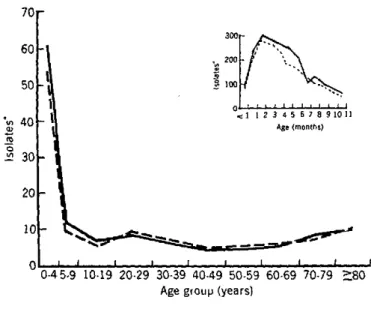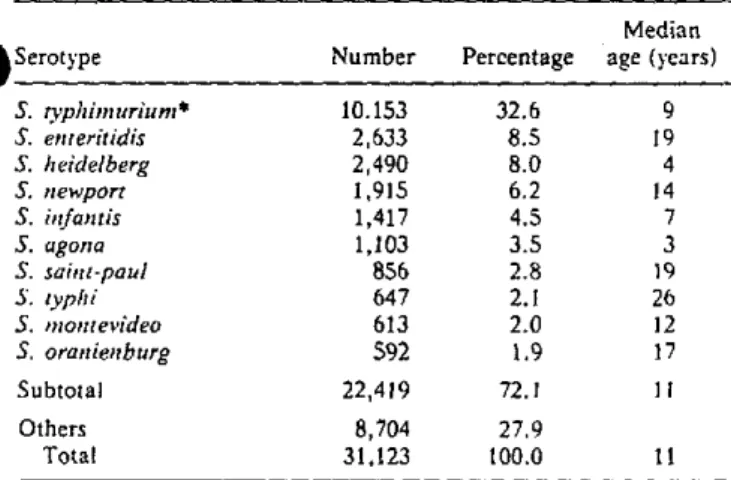from Zulia, Yaracuy, Apure, and Guárico were tested also with western equine encephalitis (WEE) antigen,
but no antibodies against this virus were found.
Table 1 describes the EEE situation in the states that were visited for the purpose of conducting the serologic survey or establishing the etiology of cases of encephalitis in equines.
Predictably, the above information indicates that EEE activity is related to the presence of surface waters such as swamps, marshes, and ponds, and possibly to water-fowl and mosquito populations; this situation is observed in Delta Amacuro and in the southwestern part of Lake Maracaibo. The opposite occurs in semidesert areas, where stagnant surface waters, if they exist at all, are found only during brief periods in the short rainy season;
the same is true along the Caribbean coastal area of Zulia and Falcón, where EEE does not exist.
Epidemiological differences between EEE and VEE are marked in these arid zones where recurrent and ex-plosive VEE epidemics are observed. Between the two above-described extremes, a range of ecological combi-nations prevails with varying grades of EEE activity, which includes small local outbreaks, To date there is no evidence of EEE infection in man.
(Source: Boletín Epidemiológico Semanal 7, 1980. Ministry of Health and Social Welfare of Venezuela)
Human
Salmonella
Isolates-United States, 1979
In 1979, 31,123 isolations of salmonellae (including Salmonella typhi) from humans were reported to CDC-an increase of 8.3 per cent over 1978.
The increase in isolates was not confined to one state or region. However, five states-Connecticut, Massa-chusetts, Maryland, Washington, and Illinois-ac-counted for two-thirds of the 8.3 per cent increase. S. enteritidis alone accounted for over one-fourth of the increase; most of this occurred in Connecticut and Massa-chusetts. S. enteritidis, S. heidelberg, S. saint-paul, and S. infantis accounted for almost two-thirds of the in-crease. These additional isolates were not concentrated in any single age group. The 10-19 year age group sus-tained the largest percentage increase, but increases were also seen for the age groups 30-39 years and 50-79 years. The age distribution of persons from whom isolates were obtained (Figure 1) followed a well-established pat-tern: the rate was highest for infants approximately 2-3 months of age, decreased rapidly through early child-hood, and then held fairly constant from approximately age 7 through the adult years. Isolation rates for those under 20 were higher for males than for females, but for
Figure 1. Rate of reported isolates Qf Salmonella, by age, United States, 1979.
70
r
60 50
s 400
0M
. 30
.200
2100
eCl 1234567891011
Age (months)
1-
201-
10-0-45.9 10-19 20-29 30-39 40-49 50-59 60-69 70-79 >80 Age group (years)
--- Female - Male
'Per 100,000 population
9
e
_
ii
. .
=i.C
-0)
Table 1. The 10 Salmonella serotypes most frequently iso-lated in human beings, United States, 1979.
a
SerotypeS. .vphimuriurn* S. enteritidis
S. heidelberg S. newport
S. infantis
5. agona S. saint-paul $. typhi 5. montevideo
S. oranienburg
Subtotal
Others Total
Median Number Percentage age (years)
10.153 32.6 9
2,633 8.5 19
2,490 8.0 4
1,915 6.2 14
1,417 4.5 7
1,103 3.5 3
856 2.8 19
647 2.1 26
613 2.0 12
592 1.9 17
22,419 72.1 11
8,704 27.9
31,123 100.0 11
*Includes S. typhimurium var. copenhagen.
persons from 21 through 74 years old, females showed a slightly higher reported isolation rate.
The 10 most frequently isolated serotypes accounted for almost three-fourths of the total (Table 1). The variation in median age of persons from whom a particular sero-type was isolated may indicate differences in the vehicles, the infectious dose, or other variable. For most serotypes, the median age of infected patients has been consistent for the 17 years during which surveillance records have been maintained. Of the 647 isolates of S. typhi in 1979, 50 were from carriers, 153 from infected patients, and the rest were undesignated. The median age of the car-riers was 59 years; of the infected patients, 17 years; and of those unspecified, 22 years.
(Source: Center for Disease Control, Morbidity and Mortality Weekly Report 29(16):18, 1980.
Cholera in the World in 1979
A total of 54,179 cases of cholera had been reported to WHO as of 29 April 1980. This figure represents a 27.4 per cent decrease compared with the 74,632 cases re-ported in 1978 (Table 1). Only two additional countries were infected in 1979 compared with eight in 1978.
The two additional countries affected were in Africa: Gabon and the Sudan, which reported 5 and 207 cases,
respectively. All together, 18 African countries were
affected, as mnany as in 1978. The total number of cases in Africa fell from 23,317 in 1978 to 18,996 in 1979,
Table 1. World cholera situation, 1974-1979.
1974 1975 1976 1977 1978 1979 Number of countries
reporting cholera 40 29 27 35 40 42 Number of new infected
countries 4 1 - 3 8 2
Number of cases 110,890 92,123 66,020 58,087 74,632 54,179
10

